 |
 |
 |
| |
Predictors of response to TPV/r in pediatric patients: results of BI1182.14/PACTG1051
|
| |
| |
Reported by Jules Levin
CROI Feb 2007, Los Angeles
JC Salazar1,2, P Cahn3, M Della Negra4, G Castelli-Gattinara5, C Fortuny6, P. Flynn1,7, R Yogev1,8, PK Ruan1,9, J Mikl10, A Jelaska10
1PACTG1051 study team; 2Connecticut ChildrenÕs Medical Center, Hartford, CT, USA; 3Fundaci—n Huˇsped, Buenos Aires, Argentina; 4Instituto de Infectologia Em’lio Ribas, S‹o Paulo, Brazil; 5Children Hospital Bambino Ges¯, Rome, Italy;
6Hospital Sant Joan de Deu, Barcelona, Spain; 7St. Jude ChildrenÕs Research Hospital, Memphis, TN, USA; 8ChildrenÕs Memorial Hospital, Northwestern University Medical School, Chicago, IL, USA;
9SDAC/Harvard School of Public Health, Boston MA, USA; 10Boehringer Ingelheim Pharmaceuticals, Inc., 900 Ridgebury Rd, Ridgefield, CT, USA
Author Conclusions
- TPV/r is an effective and well-tolerated treatment option for treatment experienced, HIV-positive children. (see viral responses by age-group in table below)
- Patients in the TPV/r high dose group were more likely to achieve higher GIQ values.
- Logistic regression analyses identified the following predictors of response (VL <400 copies/mL at 48 weeks):
- GIQ was the strongest predictor
- adherence was also a significant predictor
- baseline VL >100,000 copies/mL was a negative predictor
- age group was not a significant predictor (age is a surrogate for baseline resistance).
Abstract
Background: Many antiretroviral experienced, HIV-positive children have genotypic evidence of resistance to currently available ARV therapy. New options are needed for this population. Tipranavir (TPV) is a new generation protease inhibitor (PI) active against multi-PI resistant HIV. This analysis sought to define the predictors of response to TPV-based regimens in children.
Methods: 115 children (2-18 years) were randomized to low dose (LD) TPV/r
(n = 58, 290/115 mg/m2) or high dose (HD) TPV/r (n = 57, 375/150 mg/m2) plus optimized background regimen. Multivariate logistic regression (LR) analysis was performed to determine the predictors of Week 48 virological outcomes.
Results: Baseline mean viral load (VL): 4.7 log10 copies/mL; mean CD4 (CD4%): 492 cells/mm3 (20%); median previous ARVs: 6; genotypic resistance
to all PIs: 49.6%. Most common background regimen: 2 NRTI; enfuvirtide use: 13%.
At Week 48 (NCF), 39.7% (34.5%) of LD patients and 45.6% (35.1%)
of HD patients achieved VL <400 (<50) copies/mL. 6% of patients developed
Grade 3 ALT elevations.
Logistic regression (LR) models were implemented to investigate the associations between achieving VL<400 copies/mL at week 48 and the potential factors. The factors considered were genotypic inhibitory quotient (GIQ); baseline VL; age group; TPV adherence (defined as % of visits when TPV adherence was
95-120%); genotypic sensitivity score (GSS); and dose group. The LR results are summarized in the following table.
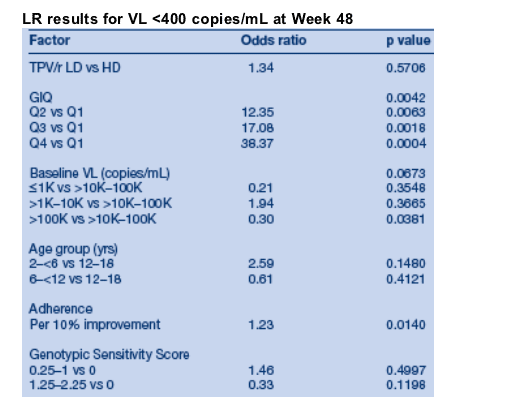
Conclusions: TPV/r regimens are well tolerated and effective in ARV experienced children. Higher GIQ values and better adherence were associated with achieving a VL <400 copies/mL.
Introduction
Tipranavir (TPV) is a non-peptidic protease inhibitor (PI) that was approved in the USA and Europe in 2005 for use in antiretroviral (ARV) experienced adults. It is co-administered with low-dose ritonavir (TPV/r). TPV inhibits the replication of HIV variants harboring multiple PI-associated resistance mutations [1,2]. In the RESIST studies, adult patients, infected with virus that exhibited reduced susceptibility to at least two PIs, who received TPV/r achieved a superior virological response to those taking a comparator PI/r [3].
TPV is available as a soft-gelatin capsule. An oral solution of TPV has been developed for use in pediatric patients.
The purpose of the BI1182.14/PACTG1051 study was to evaluate the safety, tolerability, pharmacokinetics, and antiviral activity of TPV oral solution in combination with low dose ritonavir at two dosage levels in ARV-na•ve and
-experienced pediatric patients [4]. Population pharmacokinetic (PK) data, as well as Week 48 safety and efficacy results, have been reported [4-6].
At Week 48, 39.7% (23/58) of low dose patients and 45.6% (26/57) of high dose patients in the BI1182.14/PACTG1051 study achieved a VL <400 copies/mL [4]. Over one third of patients achieved VL <50 copies/mL at Week 48: 34.5% (20/58) of low dose patients and 35.1% (20/57) of high dose patients. At Week 48, CD4% values had increased by 5% and 3% (LOCF, as treated), respectively. TPV/r was effective in all three age groups in terms of virological responses. TPV/r treatment was safe and well tolerated in this pediatric population with a safety profile similar to that seen in adult studies [4].
The aim of this analysis was to define the predictors of response to TPV-based regimens in children.
Methodolgy
Description of the trial
BI1182.14 was an open label, international study, performed in collaboration with the Pediatric AIDS Clinical Trials Group (PACTG) under protocol number PACTG1051. A total of 26 study sites participated: 10 in the United States, one in Argentina, two in Brazil, two in Canada, three in France, three in Germany, two in Italy, one in Mexico and two in Spain.
HIV-infected children and adolescents were enrolled, regardless of prior ARV therapy or HIV resistance status. All patients had to have a viral load (VL) >1,500 copies/mL at study entry; however, a few patients had lower VLs than this at baseline. Patients were stratified according to age (2 to <6 years, 6 to <12 years and 12 to 18 years) and randomized to one of two doses of TPV/r (low dose TPV/r 290/115 mg/m2 or high dose TPV/r 375/150 mg/m2) plus at least two non-PI ARVs, chosen by the investigator. Dosing was based on body surface area (BSA); however the maximum dose could not exceed TPV/r 500/200 mg BID. TPV was initially administered as an oral solution to all patients. Children who were ³12 years and who were taking the 500/200 mg dose of TPV/r were able to switch to TPV capsules after Week 4. Adherence was defined as the percentage of visits in which TPV adherence was reported as being 95-120%. This result was divided by 10 for the analysis, in order to make 10% increments in adherence.
Figure 1 depicts the patient disposition in the BI1182.14/PACTG1051 trial through Week 48. A total of 41 patients in the low dose group and 47 patients in the high dose group completed 48 weeks of treatment. Seventeen patients in the low dose group and 10 in the high dose group discontinued study medication prematurely because of adverse events (8.7%, 10/115), non-adherence (5.2%, 6/115), withdrawn consent (1.7%, 2/115) and other reasons.
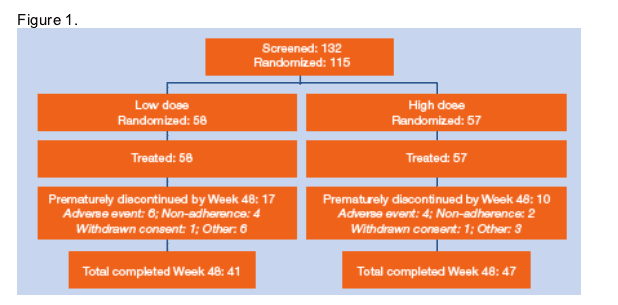
Description of the multivariate model
Logistic regression modeling was implemented to investigate associations between VL reduction to <400 copies/mL at Week 48 and a number of explanatory variables, as well as to control for potential confounding. A logistic regression was used to examine the effects of treatment group, genotypic inhibitory quotient (GIQ), baseline VL, age group, TPV adherence, and genotypic
sensitivity score (GSS) on the virologic outcome at Week 48.
The analyses were based on intent-to-treat (ITT) with non-completers considered failure (NCF) analysis.
Description of the GIQ and GSS calculations
Genotypic inhibitory quotient (GIQ) was defined as the median TPV trough level divided by the number of TPV mutations detected in a patientÕs HIV isolate at baseline (Table 1).

For patients who had no TPV mutations in their isolates, the mutation score of zero was set at 0.5 to avoid division by zero. Patients with trough levels below the limit of quantification were excluded from this analysis, as such low trough levels were considered indicative of non-adherence. GIQ results were divided in quartiles for the analysis.
A genotypic sensitivity score (GSS) was derived as a measure of sensitivity to the ARV background regimen. Each background ARV medication was assigned a value of 0, 0.25, or 1 based on pre-defined criteria. The sum of these values was the GSS for each patient.
Results
Baseline characteristics
There were 25 (21.7%) patients aged 2 to <6 years; 38 (33.0%) aged 6 to <12 years; and 52 (45.2%) aged 12 to 18 years. With the exception of the youngest patients, the number of patients randomized to the TPV/r low and high dose groups within each of the age categories was identical. Among the 2-<6 year old patients, 13 and 12 were randomized to TPV/r low and high dose, respectively.
The overall median baseline VL was 4.7 log10 copies/mL (4.9 log10 copies/mL in the low dose group and 4.7 log10 copies/mL in the high dose group). Baseline virological parameters were comparable between the two treatment groups and between the age cohorts as described previously [4].
As expected, the older patients had had more ARV experience than the younger ones. The median number of prior ARVs was three in the 2 to <6 age group; eight in the 6 to <12 age group and 10 in the 12 to 18 age group. The number of ARVs taken previously was similar, both between the two TPV/r dose groups and within each of the age groups.
The TRUGENEØgenotyping assay was used to determine baseline HIV resistance. Samples were available for analysis for all 115 randomized patients. Overall, there was a median of 13 protease gene mutations in the HIV isolates: 10 in the 2 to <6 age group, 13 in the 6 to <12 age group and 17 in the 12 to 18 age group (Table 2). The majority of the patients, 68.0%, (17/25) in the 2 to <6 age group had 12 mutations, compared to 47.4% (18/38) in the 6 to <12 age group and 30.8% (16/52) in the 12 to 18 age group. The median LPV mutation score increased from 2.0 in the 2 to <6 age group to 4.5 in the 6 to <12 age group and 6.0 in the 12 to 18 age group. The TPV-related mutations also increased in the older age groups, indicating higher levels of resistance. The number of isolates with at least one of the four key mutations (at positions 33, 82, 84, 90) was 36.0% (9/25) in the 2 to <6 age group compared to 50.0%
(19/38) in the 6 to <12 age group and 69.2% (36/52) in the 12 to 18 age group.
The median TPV mutation score was 1.0, 2.5 and 3.5, respectively, in each age
group. There were no significant differences in baseline genotype mutations
between the dose groups overall or within each age group.
Overall, 49.6% (57/115) of patients had HIV isolates that were resistant to all PIs tested; the prevalence ranged from 53.0% (61/115) resistance to lopinavir to 67.0% (77/115) resistance to atazanavir. Higher levels of resistance were identified for NRTIs: >80% of isolates showed resistance to ddC (82.6%, 95/115), abacavir (81.7%, 94/115), d4T (80.9%, 93/115) and zidovudine (80.9%, 93/115).
Approximately 70% of isolates were resistant to NNRTIs.
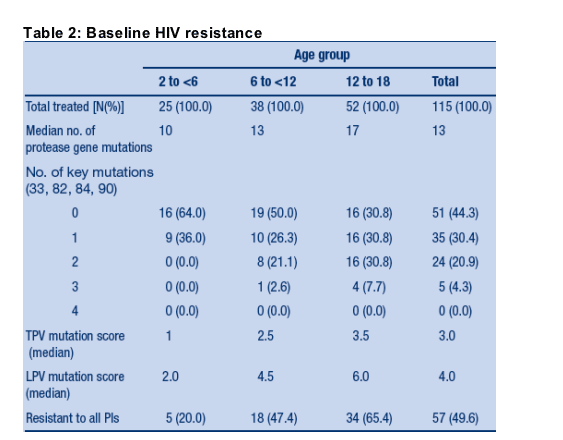
Virological results by age group
The proportion of patients with a VL <400 copies/mL at Week 48 stratified by age group is shown in Figure 2. Overall, 39.7% of patients in the low dose group (26/57) and 45.6% patients in the high dose group (23/58) achieved a VL <400 copies/mL. This difference was not statistically significant.
A higher proportion of patients achieved a VL<400 copies/mL in the 2 to <6 age group than in the 6 to <12 age group and the 12 to 18 age group. In the 2 to <6 age group, the proportion of patients with a VL <400 copies/mL was higher in the TPV/r low dose group (76.9% vs. 66.7%) than in the high dose group. However, in the two older age groups, the proportions of patients with a VL <400 copies/mL were higher in the TPV/r high dose group: 42.1% vs. 31.6% in the 6 to <12 age group and 38.5% vs. 26.9% in the 12 to18 age group. These differences were not statistically significant. A similar pattern of response was observed for the proportion of patients with <50 copies/mL.

Week 48 safety data
The most frequent adverse events were gastrointestinal: vomiting (37.4%), diarrhea (24.3%), and nausea (16.5%). These occurred at rates similar to those observed in adult trials of TPV/r [3]. Cough (27.0%) and pyrexia (24.3%) were also among the most frequent events; however these were not considered to be study drug related.
Six percent of patients developed Grade 3 ALT elevations. All of these events were asymptomatic. There were no cases of Grade 3 or 4 AST/ALT elevations in the 2 to <6 years age group. The rate of transaminase elevations in children and adolescents was similar to that in adults enrolled in the RESIST study [3].
Virologic response based on GIQ
GIQ values were calculated for 101 patients (Table 3). Values ranged from 0.28 to 215.38; approximately half of the patients had GIQ values of 7.23-38.61 (Table 3). In general, patients in the high dose group had higher GIQ values than those in the lower dose group (Table 3). This was due to higher TPV trough values in most patients who took high dose TPV/r. The difference was less marked in the 12 to 18 age group since the dose was capped at 500/200 mg and many of the adolescents in the TPV/r high dose group took this dose.

Week 48 virological response by GIQ quartiles
Week 48 virological responses, defined as a VL <400 copies/mL, stratified by GIQ quartiles are shown in Table 4.
- Virological responses increased from an 8% response rate in the lowest
quartile (2/25) to 68% (17/25) in the fourth quartile.
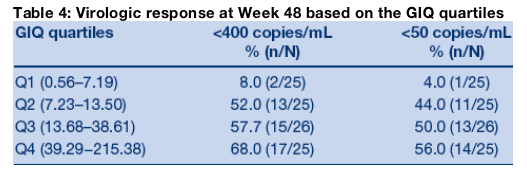
Results of logistic regression
Logistic regression modeling considered the effects of treatment group, genotypic inhibitory quotient (GIQ), baseline viral load, age group, TPV adherence, and genotypic sensitivity score (GSS).
The results of the logistic regression analysis are shown in Table 5.
- The GIQ was the strongest predictor of virological response, as defined by a VL <400 copies/mL (overall p value: 0.0042).
- Patients with GIQ values within the second, third and fourth quartiles were significantly more likely to have a VL <400 copies/mL than those with GIQ values in the first quartile.
- Adherence was statistically significant (p=0.0140), indicating that for each 10% increase in TPV adherence rate, there was a corresponding 23% increase in the likelihood that a patient would achieve a VL <400 copies/mL at Week 48.
- Overall, the baseline VL was marginally significant (p=0.0641). However, patients with a VL >100,000 copes/mL were significantly less likely to achieve virologic response than those with VL <100,000 copes/mL.
- Although differences in virologic response between the age groups were observed, once controlling for other factors such as GIQ and treatment adherence, age group became a non-significant predictor in the LR model. This is because age was a surrogate for viral resistance, which was accounted for by the GIQ factor.
- Treatment dose group and GSS value were also not significant predictors for
VL <400 copies/mL response at Week 48.
Logistic regression modeling was also used to determine if predictors of response in terms of achieving a VL <50 copies/mL could be defined. However, the model became unstable and yielded invalid results.
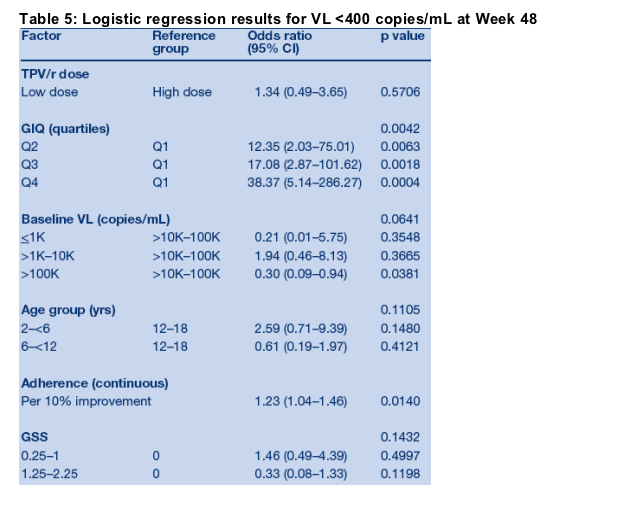
References
1. Larder, B., et al., Tipranavir inhibits broadly protease inhibitor-resistant HIV-1 clinical samples. AIDS, 2000. 14: p. 1943-1948.
2. Baxter, J.D., et al., Genotypic Changes in Human Immunodeficiency Virus-1 Protease Associated with Reduced Susceptibility and Virologic Response to the Protease Inhibitor Tipranavir. J Virol, 2006. 80(No. 21): p. 10794-10801.
3. Hicks, C.B., et al., Durable efficacy of tipranavir-ritonavir in combination with an optimised background regimen of antiretroviral drugs for treatmentexperienced HIV-1-infected patients at 48 weeks in the Randomized Evaluation of Strategic Intervention in multi-drug reSistant patients with Tipranavir (RESIST) studies: an analysis of combined data from two randomised open-label trials. Lancet, 2006. 368(9534): p. 466-75.
4. Salazar, J., et al. Efficacy and safety results of 48 weeks of treatment with APTIVUS oral solution co-administered with low dose ritonavir (APTIVUS/r) in children and teenagers (Phase I/IIa study). In XVI International AIDS Conference. 2006. Toronto, Canada. Ab. WEAB0301.
5. Sabo, J., et al. Population Pharmacokinetic (PK) Assessment of Systemic Steady-State Tipranavir (TPV) Concentrations for HIV+ Pediatric Patients Administered Tipranavir/Ritonavir (TPV/r) 290/115 mg/m2 and 375/150 mg/m2 BID (BI 1182.14 and PACTG 1051 Study Team). In 13th Conference on Retroviruses and Opportunistic Infections. 2006. Denver, USA. Abs 687.
6. Giaquinto, C., et al. Efficacy of tipranavir oral solution co-administered with low dose ritonavir (TPV/r) is similar in all age groups of children and teenagers after adjustment for resistance. In 8th International Congress on Drug Therapy in HIV Infection. 2006. Glasgow, UK. Abs. P361.
|
| |
|
 |
 |
|
|